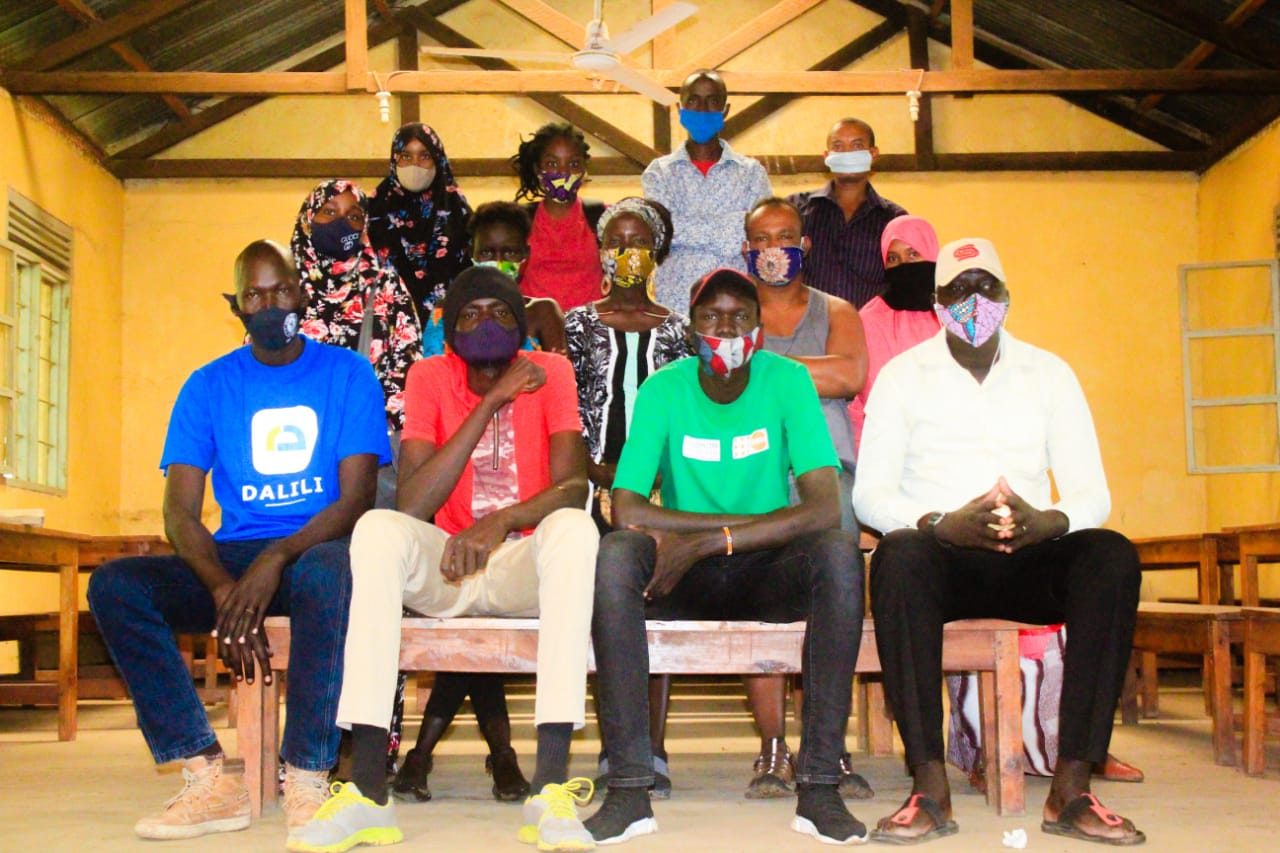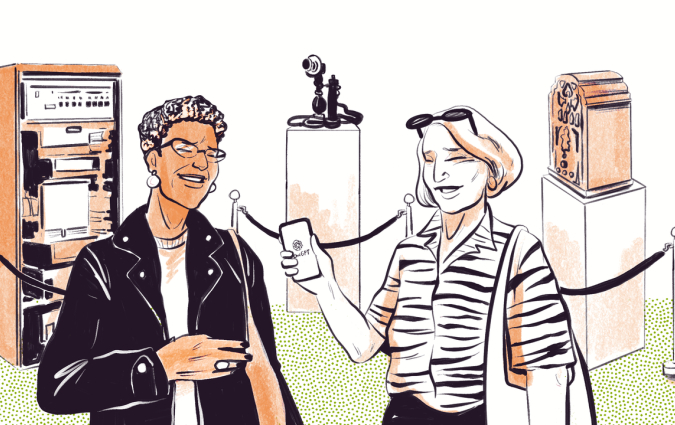How a small team of journalists report on one of the biggest refugee camps on earth

Kanere's team.
In northwest Kenya, the town of Kakuma lies 100km from the border with South Sudan. On its outskirts, around 222,000 people live in the Kakuma refugee camp and the neighbouring Kalobeyei Integrated Settlement, a population close to that of Lille in France, Birmingham in the UK or Richmond in the US. The Kakuma Camp spreads across 15km². Like many other places of this size, it has its own library, its own football teams, its own market and its own news outlet, the Kakuma News Reflector, better known as Kanere.
Staffed by refugees, Kanere covers every aspect of life in the refugee camp and aims to publish six editions a year, with more regular updates via social media. At the heart of the work of its newsroom is challenging the narrative of aid agencies and telling the stories of Kakuma’s diverse population of residents. People from more than 19 nationalities live in the camps. Refugees from South Sudan are the majority of the population of Kakuma.
Through their own experience as refugees, Kanere’s journalists are uniquely positioned to hold authorities accountable. But this creates a set of distinct operational and financial challenges for the title and its team.
“It’s a quest for representation. Aid agencies do stories from their own perspective, targeting donors’ money, and this side of the story is neglected,” says Tolossa Asraf, Kanere’s editor and team leader in Kakuma, who has lived there for almost 10 years. Asraf, who studied journalism in Ethiopia, has been working at the publication for around six years.
“The outside world wouldn’t have any idea of what’s going on inside the refugee camp,” he says. “Kanere is creating accountability for organisations that have been assuming that they are the sole owner of refugees’ [stories]. We share stories from both sides, and not only from the refugees’ side.”
The editorial strategy
Recent reports cover local news, from fights between communities in the camp to the death of a local football player. However, it’s ongoing protests by refugee teachers over low pay and pay discrimination what has dominated the newsroom’s agenda for months.
“We focus on stories that might change something in a refugee’s life, whether that’s flooding, corruption allegations against aid agencies, documentation issues, a problem with the health system or a rise in suicides. Anything that can impact refugees’ lives is of interest to us,” says Asraf.
“I've seen humanitarian organisations encouraging the perpetuation of refugee warehousing, seeing refugees as numbers and using them to make a campaign for international aid rather than being proactive and finding solutions,” says founding editor Qaabata Boru. “One of our goals was to find a mechanism through which refugees can express themselves and speak directly to the world.”
Having trained as a journalist in Ethiopia, Boru worked as a primary school teacher in Kakuma and began Kanere as a school club. Kanere’s reporting on changes to education in the camp and low pay for refugee teachers cost him this job. In 2008, the newspaper went online. In 2009 was able to migrate to WordPress and establish a team thanks to a collaboration with an independent researcher from the US state department and their funding.
How the newsroom works
The newsroom is staffed by volunteers who work around their day jobs but meet at least once a week as an editorial team – often in Asraf’s shelter. Around 10 active members of newsroom staff – reporters from South Sudan, Ethiopia, Burundi, DRC and Kenya – cover stories from across Kakuma, which is divided into four numbered areas. To reduce transportation costs and time, the team tries to assign reporters stories that are happening in their area and has contributors based in Kalobeyei, around 3.5 kilometres away.
“People who follow us think we are a big operation. We are small. We have no office. I use my phone to do stories,” says reporter Baluu W. Makuach, who has worked with Kanere since 2018. Makuach’s parents have lived in Kakuma since 1992 and he resettled to Germany himself a few weeks after speaking to me. As a refugee reporter telling refugee stories, he proudly recalls reporting on the exam success of a student who had arrived in Kakuma as a result of the civil war in South Sudan and on a story on students developing liquid soap to sell during the COVID-19 pandemic.
“People normally see us on social media, but they don’t know we are operating from one person’s house,” he says. It’s a voluntary role, but the passion I feel (...) it’s home for me.”
The key challenges
Capacity is an ongoing challenge with the potential resettlement of reporters as an additional factor: replacing three recently resettled staff has proved difficult and reduced the newsroom’s output. The website hasn’t been updated since September. Every journalist is also dealing with their own refugee experience.
“There’s no way to upgrade yourself. There’s no way to learn. It’s totally cut off from the outside world,” says Asraf. The newsroom has a very old voice recorder that requires batteries and some donated equipment from international journalists and media organisations that have visited the camp. Kanere reporters rely on smartphones to record interviews. With no fixed electricity in the camp, solar power and a generator used in the evenings allow the team to charge equipment, file stories and update Kanere’s website and social channels. Support also comes from Boru, who lived in Kakuma for four years and is now based in Canada where he continues to edit stories.
Approaching and gaining the trust of other refugees can be additionally challenging for Kanere’s staff. An innate fear of reprisal or risking an application for resettlement often outweighs the assistance of much-needed attention that an investigation by Kanere can bring, says Makuach. Building trust has been crucial, in particular, when reporting on sensitive issues, such as suicides in the camp, and the teachers’ protests, he says.
“Most of the refugees fear because not everyone knows what their position is or their rights,” he says. “I always introduce myself as a refugee journalist and reassure them that we can keep details private or make names anonymous. Community leaders can help. In Kakuma, they want people they can trust, but they don’t always trust us because we aren’t always part of their community or we don’t speak their language.”
How to stay independent
Kanere’s independence from aid agencies is paramount to its team but creates a unique challenge for this refugee-staffed newsroom. “The relationship with aid agencies is not smooth. Journalists in any part of the world have challenges, but ours are quite different. They are giving us relief food and we criticise them – it’s a paradox,” says editor Asraf. Relations with the UNHCR have improved in recent years, according to Asraf and Boru, with the agency more willing to give interviews or comment on stories, including the recent teachers’ strikes.
In order to remain independent and hold aid agencies accountable, Kanere will not take funding from the UNHCR. NGOs willing to fund Kanere typically receive some funding from the UN so they are also ruled out. Securing consistent and sustainable funding is arguably the outlet’s most pressing challenge. It’s reliant on donations from supporters and occasional grants. When available, these grants show the potential of a fully-funded newsroom. Support from the German foreign office during the COVID-19 pandemic provided a small budget and some additional staff to produce crucial public health coverage in multiple languages. “In my opinion, our reporting saved lives,” says Asraf.
“We’re not looking for huge funding but something that will keep us going in terms of logistics,” says Boru. Using the boda boda motorbike taxis in the camp is an expensive way to gather news and limited equipment means journalists are often waiting for one of the team’s two cameras to return before they can go on assignment. Funding would allow more stories to be published and a small investment in Kanere’s website. Stories are currently published online 1-2 months late, says Boru: “If there’s more funding or support we aim to publish every month.”
A minimum of $2,000 a month would cover the newsroom’s essentials, says Boru, but funding of $3,000-$5,000 a month would support four editions of Kanere, published every two months, and provide a small stipend for reporters. An increase to $10,000 every four months would support a monthly online edition and an accompanying print run of 500 to reach Kakuma’s most vulnerable refugees and those who don’t have access to a phone.
What's next for 'Kanere'
Reports suggest the Kenyan government has committed to closing Kakuma Camp by June 2022. Kanere’s reporters are reliably sceptical of the news. “It’s threatening refugees with closure when there’s no clear roadmap,” says Boru. “I feel these are just ongoing threats and the government might also use them to get more aid, but refugees still feel the threat.”
Makuach says the news of planned closures is already having an effect on communities. Some shops are no longer taking payment on credit, for example. Yet, at the same time, the UNHCR is building permanent structures in the camp: “I have family members who don’t know where they would go. They can be traced to a village but have never been there. These people don’t know these places. Trying to get them back will be a great challenge.”
“If there’s the closure of refugee camps, it’s good for Kanere; we’d like to see the end of warehousing refugees,” says Boru. With additional funding, the outlet wants to publish in more languages, including Kiswahili and Arabic, to reach more people in Kakuma, including its more than 100,000 South Sudanese residents.
But ambitions for Kanere stretch beyond the camp too. It’s now a registered NGO in Kenya, has a reporter based in another refugee camp and connections with a camp in Uganda and refugees outside of Kenya. Two reporters work as urban reporters in Nairobi covering urban issues for a refugee audience and with a displaced audience in mind.
“I know we are influential and have a lot of supporters inside the camp and also people outside who are interested in migration and refugee stories,” says Asraf. “They see us as a watchdog against agencies and authorities.”
“I wish Kanere could be an international outlet to represent displaced people all over the world. I also wish we were accepted by the aid agencies positively so that they could see Kanere as supportive rather than an enemy,” he says. “I wish Kanere could have a print version and a staff budget. I wish Kanere to be a big media operation.”
Laura Oliver is a freelance journalist based in the UK. She has written for the Guardian, BBC, The Week and more. She is a visiting lecturer in online journalism at City, University of London, and works as an audience strategy consultant for newsrooms. You can find her work here.
In every email we send you'll find original reporting, evidence-based insights, online seminars and readings curated from 100s of sources - all in 5 minutes.
- Twice a week
- More than 20,000 people receive it
- Unsubscribe any time




